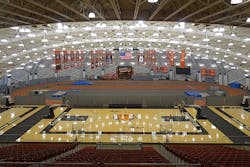Princeton retrofits Jadwin Gym with LED lighting and wireless controls
Ivy League school updates its 250,000-square-foot athletic facility with 839 Hubbell SSL fixtures and deploys the company's wiSCAPE network control system.
Hubbell Lighting has announced a networked LED-based lighting project at the L. Stockwell Jadwin Gymnasium (Jadwin Gym) on the campus of Princeton University in New Jersey. The university expects the Hubbell Lunabay Series LED high-bay fixtures to deliver 40% baseline energy savings relative to the prior metal halide (MH) lighting and that the controls will add another 20–40% in savings. Meanwhile, the solid-state lighting (SSL) installation has earned the praise of users such as the Princeton Tigers basketball teams that have noted an improvement in the lighting conditions on the court.
Interested in more articles & announcements on LED sports lighting & entertainment applications?
We have seen an increasing number of athletic facility LED projects in recent years as LED-based products can now produce the required light levels for competition. For example, GE Lighting supplied SSL for a Boston University track and tennis center. And Cree recently supplied LED-based high-bay fixtures for the Bowling Green State University Perry Field House.
Still, the Princeton Jadwin Gym project is unique in that it is a multipurpose facility with 250,000 ft2 of space. The university said the gym includes more total area than eight football fields. In addition to Division 1 NCAA men’s and women’s basketball games, the facility hosts track events, wrestling, fencing, squash, and a host of other university activities including concerts and speeches by notable personalities such as former US Secretary of State Condoleezza Rice.
It's the diversity of use that made control a very significant part of the LED sports lighting project. For some events, all of the lighting must be turned on, but often there is only a need to light portions of the facility with most of the lighting dimmed to low levels or extinguished. Princeton said the new lighting allows control of lights down to a "specific row in the spectator bleachers."
Control is via the aforementioned wiSCAPE system from Hubbell Building Automation that includes a wireless network gateway that can communicate with as many as 1000 SSL fixtures equipped with wiSCAPE nodes. The system relies on wireless communication in the 2.4-GHz ISM (industrial, scientific, and medical) band set aside in the US for unlicensed wireless communications.
Still, it's the quality of illumination that is key to the users and for sports that are televised such as basketball. Hubbell said the uniformity and CRI were scrutinized to ensure that TV broadcasts would be optimized.
"The new lighting system exceeds the expectations of the Athletics department," said Aramark/Princeton senior project manager Brian Robertson. "The players, coaches, and staff have all commented on the improvement and how excited they are to play under the new lights. Hubbell Lighting was a true partner in this process and we look forward to playing under their lights this season and many seasons to come."
Of course, the 50,000-hr rated life of the LED fixtures was also an important consideration. The MH lighting had required regular lamp and ballast replacement, which was especially difficult with the domed roof of the facility and required the use of aerial high-reach lifts.
The Jadwin Gym project is one of several on the Princeton Campus. It was done as part of the Campus Wide Lighting Efficiency Upgrade Program. We recently covered several outdoor SSL projects on the campus that were part of the US Department of Energy (DOE) Gateway program for LED-based lighting projects.

Maury Wright | Editor in Chief
Maury Wright is an electronics engineer turned technology journalist, who has focused specifically on the LED & Lighting industry for the past decade. Wright first wrote for LEDs Magazine as a contractor in 2010, and took over as Editor-in-Chief in 2012. He has broad experience in technology areas ranging from microprocessors to digital media to wireless networks that he gained over 30 years in the trade press. Wright has experience running global editorial operations, such as during his tenure as worldwide editorial director of EDN Magazine, and has been instrumental in launching publication websites going back to the earliest days of the Internet. Wright has won numerous industry awards, including multiple ASBPE national awards for B2B journalism excellence, and has received finalist recognition for LEDs Magazine in the FOLIO Eddie Awards. He received a BS in electrical engineering from Auburn University.






